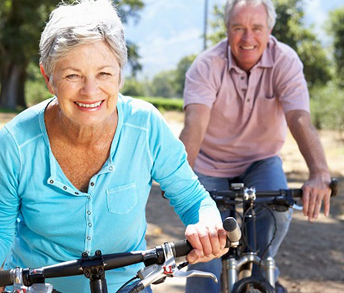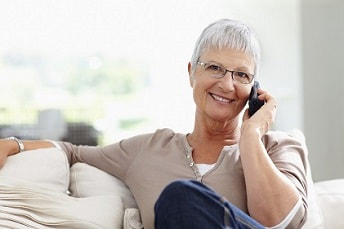Most baby-boomers “coming of age” wish to maintain their active lifestyles. However as we age, our bodies change. These changes come in in the form of lost vitality and function of our skin, muscles, bones, and circulation.
By incorporating massage into a regular healthcare regimen, many older adults find a better quality of life and additional relief from a multitude of health issues.
By incorporating massage into a regular healthcare regimen, many older adults find a better quality of life and additional relief from a multitude of health issues.

Research conducted by the American Massage Therapy Association (AMTA):
According to Jo Ellen Sefton, Director of the Neuromechanics Research Laboratory at Auburn University, massage has been demonstrated to help treat chronic pain, particularly in joints, such as the shoulder or knee, while also improving stability and posture. Studies suggest that regular massage may produce physiological changes that contribute to improved balance, postural control, and be a way to decrease potential falls in older adults.
- A recent national survey showed that 29% of eldercare facilities reported employing an art, massage or music therapist, with 74% of them employing massage therapists.
- Physicians and other Health-care practitioners surveyed rated massage “best among a variety of forms of alternative medicine”, with 74% indicating they believed massage was “always or usually effective.”
- Seniors who asked their doctors about massage, found that almost two-thirds “encouraged or strongly recommended massage.”
According to Jo Ellen Sefton, Director of the Neuromechanics Research Laboratory at Auburn University, massage has been demonstrated to help treat chronic pain, particularly in joints, such as the shoulder or knee, while also improving stability and posture. Studies suggest that regular massage may produce physiological changes that contribute to improved balance, postural control, and be a way to decrease potential falls in older adults.

Benefits of massage therapy on mental health and well being:
Research has shown that even a brief massage can reduce agitation behavior in older adults living with dementia, such as physical expressions of pacing and wandering. Additionally massage therapy provides clinical benefits to hospice patients, such as decreased pain and improved quality of life.
Ann Catlin, founder of the Center for Compassionate Touch and an expert in the field of massage therapy in elder care and hospice, indicates there are several benefits massage therapy offers including increased body awareness and alertness, as well as a reduction in the feelings of confusion and anxiety, allowing you to build reassurance, trust, and can calm agitation. “Massage can help ease the social effects of isolation, loneliness and boredom while encouraging feelings of worthiness and well-being.”
Massage has been indicated as a possible alternative to the use of opioids, as an important non-pharmacological therapy for managing pain, including a variety of specific chronic pain issues. As recognized by the National Institutes of Health (NIH), and included in guidelines issued by The Joint Commission and the American College of Physicians (ACP). Reference: https://www.amtamassage.org/research/index.html
- Reduce trait anxiety and depression with a course of care providing benefits similar in magnitude to those of psychotherapy.
- Increase neurotransmitters associated with lowering anxiety and decrease hormones associated with increasing anxiety.
- Significantly decrease heart rate, systolic blood pressure, and diastolic blood pressure.
- Reduce depression in individuals with terminal conditions, lessened anxiety in cancer patients, and lower work-related stress for nurses.
- Improved skincare, which is vital for bedridden patients. Massage not only increases circulation, the application of lotion moisturizes the skin and decreases the chance of pressure sores.
Research has shown that even a brief massage can reduce agitation behavior in older adults living with dementia, such as physical expressions of pacing and wandering. Additionally massage therapy provides clinical benefits to hospice patients, such as decreased pain and improved quality of life.
Ann Catlin, founder of the Center for Compassionate Touch and an expert in the field of massage therapy in elder care and hospice, indicates there are several benefits massage therapy offers including increased body awareness and alertness, as well as a reduction in the feelings of confusion and anxiety, allowing you to build reassurance, trust, and can calm agitation. “Massage can help ease the social effects of isolation, loneliness and boredom while encouraging feelings of worthiness and well-being.”
Massage has been indicated as a possible alternative to the use of opioids, as an important non-pharmacological therapy for managing pain, including a variety of specific chronic pain issues. As recognized by the National Institutes of Health (NIH), and included in guidelines issued by The Joint Commission and the American College of Physicians (ACP). Reference: https://www.amtamassage.org/research/index.html

Choosing an Eldercare Massage Therapist:
Understanding the complexities of physiological changes that occur with aging requires both academic knowledge and technical skills. An understanding that go beyond what is typically taught in massage schools across the country.
When exploring available providers, a qualified Eldercare Massage Therapist should be able to provide evidence of their academic knowledge and technical skills. Frequently this will come in the form of continuous education hours, specialized certifications or licenses in elder care or nursing.
It’s important to note that massage for the elderly population uses different techniques to avoid harming a more fragile client, both physically and emotionally. Many massage and bodywork techniques typically used on healthy clients, may be too stimulating or painful if performed by a therapist not knowledgeable in elder care.
Understanding the complexities of physiological changes that occur with aging requires both academic knowledge and technical skills. An understanding that go beyond what is typically taught in massage schools across the country.
When exploring available providers, a qualified Eldercare Massage Therapist should be able to provide evidence of their academic knowledge and technical skills. Frequently this will come in the form of continuous education hours, specialized certifications or licenses in elder care or nursing.
It’s important to note that massage for the elderly population uses different techniques to avoid harming a more fragile client, both physically and emotionally. Many massage and bodywork techniques typically used on healthy clients, may be too stimulating or painful if performed by a therapist not knowledgeable in elder care.

Receiving the sensation of touch is especially important during end of life care. Some massage techniques can be adapted properly by a therapist, to emphasize gentle methods to ameliorate pain for the elderly. For massage with the very ill or hospice patients, frequent yet shorter sessions (15-30 minutes) may be appropriate.
As a component of your customized care, an eldercare massage therapist should be dedicated to enhancing quality of life, as a way to make living more enjoyable. A trained eldercare massage therapists will employ skillful hands-on work, paired with supervision from qualified healthcare professionals, using techniques current with trends on aging.
Eldercare facilities providing these additional services, emphasize their commitment to wellness and quality of life, by ensuring qualified insured therapists are used. Increasingly, providing massage on site has helped eldercare facilities attract senior and geriatric residents, and their families, seeking the benefits of massage for seniors.
These benefits are especially vital to seniors who are relatively sedentary, must cope with chronic health problems, and possible emotional losses. For those with Type 2 Diabetes or other threats to the circulatory system, massage can make a major contribution to maintaining health and mobility.
Research Roundup: Aging + Massage Fact Sheet for download and share
As a component of your customized care, an eldercare massage therapist should be dedicated to enhancing quality of life, as a way to make living more enjoyable. A trained eldercare massage therapists will employ skillful hands-on work, paired with supervision from qualified healthcare professionals, using techniques current with trends on aging.
Eldercare facilities providing these additional services, emphasize their commitment to wellness and quality of life, by ensuring qualified insured therapists are used. Increasingly, providing massage on site has helped eldercare facilities attract senior and geriatric residents, and their families, seeking the benefits of massage for seniors.
These benefits are especially vital to seniors who are relatively sedentary, must cope with chronic health problems, and possible emotional losses. For those with Type 2 Diabetes or other threats to the circulatory system, massage can make a major contribution to maintaining health and mobility.
Research Roundup: Aging + Massage Fact Sheet for download and share

Contact Marcia Butell today for additional information on eldercare. Include massage as a component of customized onsite care provided for your loved one, in their home or local care facility. 785-865-4372
Marcia Butell, owner of Rejuvene Salon and Spa, holds a certification from National Certification Board for Therapeutic Massage and Bodywork (NCBTMB), is a Licensed Esthetician through the Kansas Board of Cosmetology, and is a Certified Nurses Assistant (CNA) in Lawrence, Kansas.
Marcia has received over 700 hours of continuing education; including the study of anatomy, physiology, pathology, kinesiology, and has supervised clinical experience in nursing homes and hospitals.
Marcia Butell, owner of Rejuvene Salon and Spa, holds a certification from National Certification Board for Therapeutic Massage and Bodywork (NCBTMB), is a Licensed Esthetician through the Kansas Board of Cosmetology, and is a Certified Nurses Assistant (CNA) in Lawrence, Kansas.
Marcia has received over 700 hours of continuing education; including the study of anatomy, physiology, pathology, kinesiology, and has supervised clinical experience in nursing homes and hospitals.
About the Elderly Population in the US:
According to Census Bureau projections, the US elderly population will approximately double between now and the year 2050. Over the next 30 years the elderly, those 65 years of age and over, will reach 83.7 million people or as many as 1 in every 5 Americans.
The majority of this rise was projected to occur where we find ourselves today, between 2010 and 2030, when the "baby boom" generation enters their elderly years. During this period, the number of elderly will grow by an average of 2.8% annually, or over two times the annual growth of the previous 20 years. Current statistics show that 10,000 people join the ranks of the 65-year-old population every day.
According to Census Bureau projections, the US elderly population will approximately double between now and the year 2050. Over the next 30 years the elderly, those 65 years of age and over, will reach 83.7 million people or as many as 1 in every 5 Americans.
The majority of this rise was projected to occur where we find ourselves today, between 2010 and 2030, when the "baby boom" generation enters their elderly years. During this period, the number of elderly will grow by an average of 2.8% annually, or over two times the annual growth of the previous 20 years. Current statistics show that 10,000 people join the ranks of the 65-year-old population every day.



 RSS Feed
RSS Feed
